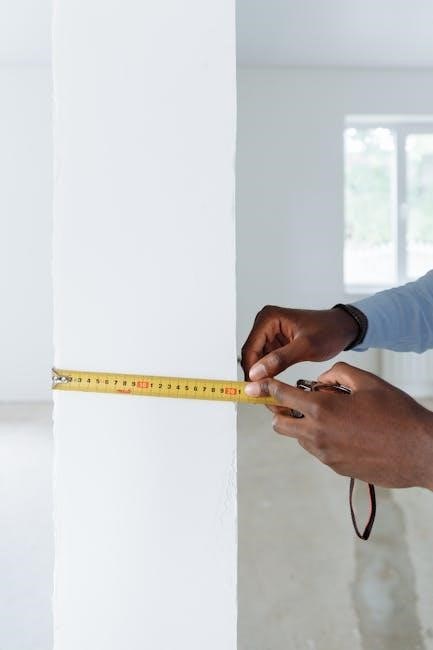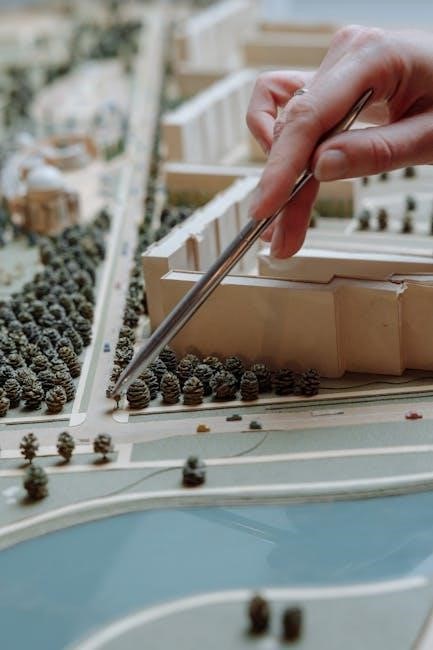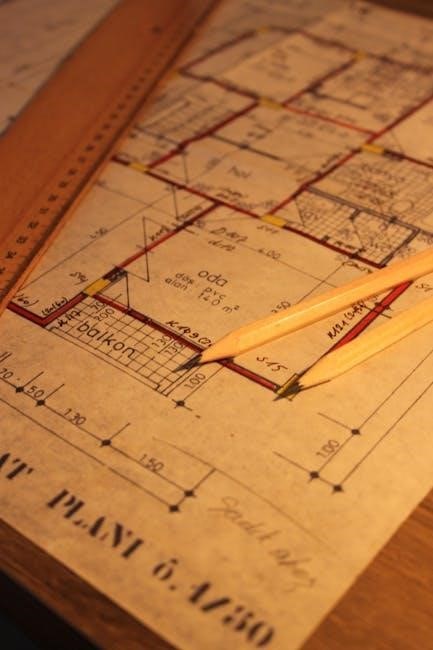N Scale track plans are a popular choice for model railroaders, offering detailed layouts in compact spaces. PDF resources provide essential guides for designing and building these setups.
1.1 What is N Scale Modeling?
N Scale modeling is a popular form of model railroading that uses a 1:160 scale ratio, making it ideal for compact layouts. Its small size allows for detailed and intricate designs without requiring large spaces. This scale is perfect for creating realistic train setups in limited areas, such as apartments or small rooms. N Scale trains are also highly portable, making them accessible to hobbyists with varying levels of experience. The scale’s versatility enables modelers to recreate diverse themes, from modern urban scenes to historic rural landscapes. Its growing popularity has led to a wide range of accessories and track plans available online, further enhancing its appeal.
1.2 Benefits of Using N Scale Track Plans
N Scale track plans offer numerous advantages for model railroaders, particularly for those with limited space. Their compact size allows for intricate designs without requiring large areas, making them ideal for small rooms or apartments. The portability of N Scale layouts is another significant benefit, enabling easy transportation to exhibitions or workshops. Additionally, N Scale models are cost-effective, as they require less material and space compared to larger scales. This scale also provides scalability, allowing modelers to expand their layouts gradually. Furthermore, N Scale track plans are widely available in PDF formats, offering a variety of creative and functional designs. These plans cater to both beginners and experienced hobbyists, ensuring versatility and adaptability.
1.3 Importance of PDF Resources for N Scale Layouts
PDF resources for N Scale layouts are indispensable for model railroaders, offering detailed and accessible guides for constructing intricate track designs. These documents provide clear diagrams, measurements, and instructions, ensuring accuracy and ease of assembly. PDFs are widely available, with many free downloads from clubs and communities, making them a cost-effective option. They cater to all skill levels, from beginners building small setups like 2×4 feet layouts to experienced modelers designing complex systems. Additionally, PDFs often include customizable plans, allowing hobbyists to adapt designs to their space and preferences. This versatility, combined with their portability, makes PDF resources a cornerstone of N Scale modeling.

Popular N Scale Track Plans Available as PDF
The Tabletop Shortline (PDF) offers a compact 20×36-inch layout, perfect for small spaces and beginners, featuring simple yet engaging track designs.
2.1 Tri-R Railroad (PDF)
The Tri-R Railroad (PDF) is a popular N scale track plan designed for a 27×48-inch space, offering a compact yet detailed layout. It features multiple tracks, a small yard, and a mainline for continuous operation. This plan is ideal for both beginners and experienced modelers, as it provides a balanced mix of simplicity and complexity. The design includes key elements like sidings, passing tracks, and a terminal area, allowing for realistic train movements. Its size makes it perfect for small rooms or starter layouts. The PDF format ensures easy access and printing, making it a versatile choice for hobbyists looking to create an engaging N scale setup.
2.2 The Tabletop Shortline (PDF)
The Tabletop Shortline (PDF) is a compact N scale track plan designed for a 20×36-inch space, making it ideal for small rooms or beginners. This layout features a simple yet functional design, including a mainline, sidings, and a small yard. Its compact size allows for easy setup and operation, perfect for those with limited space. The PDF format provides clear and detailed instructions, ensuring modelers can replicate the design accurately. This plan is great for hobbyists looking to start small or test new ideas without committing to a larger layout. Its simplicity and efficiency make it a favorite among N scale enthusiasts.
2.3 Manning Oaks (PDF)
Manning Oaks (PDF) is a versatile N scale track plan designed for a 36×72-inch layout, offering ample space for creative detailing. This plan incorporates multiple tracks, yards, and scenic elements, making it ideal for those who enjoy complex operations. The layout includes freight and passenger lines, allowing for diverse train movements. Its larger size accommodates detailed scenery and structures, enhancing visual appeal. The PDF format provides clear instructions and diagrams, making it easier for modelers to replicate the design. Manning Oaks is a popular choice among hobbyists seeking a balance between functionality and aesthetics, suitable for both experienced modelers and those looking to expand their skills.
2.4 Worlds Greatest Hobby Layout in N Scale
The Worlds Greatest Hobby Layout in N Scale is a popular and versatile track plan designed to inspire creativity and functionality. This layout is ideal for both beginners and experienced modelers, offering a balance of simplicity and complexity. It features multiple tracks, yards, and scenic elements, allowing for diverse train operations and visual appeal. The plan is space-efficient, making it suitable for various room sizes. Its PDF format provides detailed instructions and diagrams, ensuring ease of assembly. This layout is a favorite among hobbyists due to its adaptability and the opportunity to incorporate personalized details, making it a standout choice for N scale enthusiasts.

Space-Saving Layout Ideas in N Scale
N Scale track plans excel in optimizing small spaces, offering compact yet detailed layouts. These designs are perfect for hobbyists with limited room, ensuring functionality and creativity.
3.1 Small Layouts for Beginners
Small N Scale layouts are ideal for beginners, offering a manageable way to start model railroading. These compact designs, such as the 2×4 feet layout, require minimal space and materials. They allow hobbyists to practice track assembly, wiring, and scenery without overwhelming complexity. Many small layouts, like the Tabletop Shortline, feature simple track configurations, making them perfect for learning the basics. These setups also encourage creativity, enabling newcomers to experiment with different themes and designs. Starting with a small layout helps build confidence and skills, providing a solid foundation for more ambitious projects in the future.
3.2 2×4 Feet N Gauge Model Railway Layout
The 2×4 feet N Gauge layout is a popular choice for space-conscious modelers. Its compact size makes it ideal for small rooms or tabletop setups. This layout often features a simple yet functional track design, allowing for smooth train operation. Scenery and structures can be added to enhance visual appeal, creating a charming miniature world. Many PDF plans are available online, offering step-by-step guides for constructing this layout. It’s a great option for beginners, as it requires minimal materials and tools. The 2×4 layout is also a perfect starting point for those looking to gradually expand their model railway in the future.
3.3 Compact Track Designs for Limited Spaces
Compact track designs are perfect for modelers with limited space, offering creative solutions to maximize layout potential. These designs often feature modular components and space-saving techniques, such as foldable layouts or multi-level setups. Many N scale track plans in PDF format include clever ideas for small rooms or apartments. By incorporating curves, elevations, and hidden tracks, these designs maintain operational interest while minimizing footprint. They also allow for easy customization, enabling modelers to adapt the layout to their specific needs. Compact designs are ideal for beginners or experienced hobbyists alike, proving that even in tight spaces, a rewarding model railway is achievable.

Designing Custom N Scale Track Plans
Creating custom N scale layouts involves planning and creativity. Start by defining space and theme, then sketch or use software to bring your vision to life with precision and detail.
Creating a custom N scale layout begins with defining your space and theme. Start by sketching your ideas or using specialized software like AnyRail or RR-Track. Consider the purpose of your layout—whether it’s for operations, display, or scenery. Measure your available space and translate it into a scale drawing. Plan track placement, ensuring smooth curves and grades. Incorporate switches and sidings for functionality. Add scenic elements like mountains, rivers, and buildings to enhance realism. Finally, test your design with temporary tracks before committing to a final build. This step-by-step approach ensures a functional and visually appealing layout tailored to your preferences. Designing N scale track plans requires the right tools and software. AnyRail and RR-Track are popular choices, offering intuitive interfaces for creating custom layouts. These programs allow precise measurements and flexibility to experiment with designs. For manual drafting, graph paper and scale rulers are essential. CAD software like AutoCAD provides advanced features for complex designs. Additionally, apps like Track Planning Tool offer mobile convenience. Many enthusiasts also use PDF resources from brands like Kato Unitrack and Fleischmann for inspiration and templates. Combining digital tools with traditional methods ensures accuracy and creativity in your N scale track designs. Incorporating scenery and structures enhances the realism and visual appeal of N scale layouts. Start by planning the placement of buildings, bridges, and terrain using PDF track plans as a guide. Foam boards and cardboard are popular for creating hills and mountains, while kits or 3D printing can add detailed structures. Vegetation, such as miniature trees and grass, adds depth. Water features and lighting can also bring scenes to life. Ensure scenery complements the track design without obstructing trains. Many PDF resources offer templates and inspiration for integrating these elements seamlessly. Proper planning ensures a balanced and immersive layout. Notable N scale layouts showcase creativity and precision, such as Bill Baumann’s Kato Unitrack design and Fleischmann’s detailed track plans, inspiring modelers with their unique features. The Kato Unitrack layout by Bill Baumann, featured in the November 1985 Model Railroader, is a timeless N scale design. This compact setup measures 27 x 48 inches, showcasing efficient space utilization. It incorporates Kato Unitrack components, known for their ease of assembly and versatility. The layout includes a main line, passing tracks, and a siding, offering ample operational possibilities. Baumann’s design emphasizes simplicity and functionality, making it accessible to modelers of all skill levels. The use of Unitrack allows for quick modifications, enabling hobbyists to adapt the layout to their preferences. This plan remains a favorite among N scale enthusiasts, demonstrating how smaller spaces can yield engaging railroading experiences. Fleischmann N Scale track designs are renowned for their precision and versatility, offering a wide range of layouts suitable for both beginners and experienced modelers. Their modular systems simplify track assembly, allowing for seamless integration of curves, straights, and switches. Fleischmann’s designs emphasize realistic detailing and operational efficiency, making them ideal for recreating authentic rail environments. Popular layouts include compact setups like the 2×4 feet N gauge model railway, designed without slopes or gradients, perfect for newcomers. Fleischmann’s track plans are celebrated for their durability and ease of customization, making them a favorite among hobbyists seeking both functionality and aesthetic appeal in their N scale creations. Popular N scale layouts often feature unique designs that set them apart, such as multi-level tracks, hidden staging yards, and intricate scenery. The Tri-R Railroad, for instance, incorporates a compact yet detailed setup, while Manning Oaks offers expansive landscapes. Worlds Greatest Hobby Layout showcases modular components for easy customization. These designs emphasize operational efficiency and visual appeal, making them standouts in the hobby. Many layouts also include clever space-saving solutions, such as foldable or wall-mounted sections, catering to modelers with limited room. These creative elements inspire enthusiasts to experiment with their own track plans, blending functionality with artistic expression. Free PDF downloads from model railroad clubs, books, and online communities provide easy access to a variety of N scale track plans for enthusiasts. Model railroad clubs offer a wealth of free N scale track plan PDFs, catering to both beginners and experienced enthusiasts. These resources often include detailed layouts, such as the Tri-R Railroad and The Tabletop Shortline, designed to fit various spaces. Clubs like the one mentioned by Linn H. Westcott provide over 500,000 copies sold, showcasing popular plans. Many clubs also share add-on parts and Easy-Track layouts for download. These PDFs are perfect for those looking to start or expand their N scale collection, ensuring access to creative and functional designs without cost. Books and guides on N scale layouts offer comprehensive resources for model railroaders. Titles like Linn H. Westcott’s track plans provide detailed designs for N, HO, S, and O scales, with over 500,000 copies sold. These guides cater to all skill levels, from beginners to advanced hobbyists. They often include step-by-step instructions, track diagrams, and tips for customizing layouts. Books like the Kato Unitrack layout by Bill Baumann showcase innovative designs, while others focus on space-saving ideas and scenic integration. These publications are invaluable for those seeking inspiration or technical guidance, ensuring a smooth and enjoyable model-building experience. They remain essential tools for crafting unique and functional N scale setups. Online communities and forums are vibrant hubs for sharing N scale track plans and resources. These platforms allow hobbyists to exchange ideas, download PDF layouts, and collaborate on projects. Websites like Model Railroader and specialized N scale forums feature user-contributed designs, such as the Kato Unitrack layout by Bill Baumann. Members often share their custom plans, offering inspiration and practical advice. These communities also host discussions on tools, techniques, and troubleshooting. By engaging with these forums, enthusiasts can access a wealth of knowledge and resources, fostering creativity and innovation in N scale modeling. They serve as invaluable networks for both beginners and experienced modelers. Building an N scale layout involves selecting materials, assembling tracks, and adding scenery. Start with a solid base, use precise tools, and follow step-by-step guides. To build an N scale layout, you’ll need specific materials and tools. Start with a sturdy base, such as plywood or foam board, to ensure stability and prevent warping. Track pieces, including flex tracks and sectional tracks, are essential for creating the desired design. Ballast, glue, and scenic materials like grass, rocks, and paint add realism. Tools include a track cutter for precise connections, a soldering iron for wiring, and sandpaper for smoothing surfaces. Don’t forget measuring tape, clamps, and a level to ensure accuracy. Reference PDF guides for detailed lists tailored to your layout’s complexity. Start by planning your workspace and unboxing all components. Use a track cutter to trim flex tracks to size, ensuring precise fits. Lay out the track according to your PDF plan, aligning pieces carefully. Secure tracks to the base using adhesive or nails, starting from the center to avoid warping. Ballast the tracks with fine gravel for realism. Connect electrical wires to power the layout, soldering joints for reliability. Finally, test the track with a locomotive to ensure smooth operation. Refer to your PDF guide for specific tips and troubleshooting common issues during assembly. Start by carefully following your PDF plan to ensure accuracy. Measure twice before cutting tracks to avoid costly errors. Use a track cleaner to remove dirt and grease for smooth train operation. Avoid overtightening rail joiners, as this can warp the track. Begin with a simple layout to gain experience before adding complex features. Test each section of track with a locomotive before ballasting to identify issues early. Keep electrical connections clean and secure to prevent short circuits. Store unused track pieces in a dry, protected area to prevent damage. Regularly inspect your layout for alignment issues and address them promptly.4.1 How to Create Your Own Layout Plan
4.2 Tools and Software for Track Design

4.3 Incorporating Scenery and Structures

Case Studies of Notable N Scale Layouts
5.1 Kato Unitrack Layout by Bill Baumann

5.2 Fleischmann N Scale Track Designs
5.3 Unique Features of Popular Layouts

Resources for Downloading N Scale Track Plans
6.1 Free PDF Downloads from Model Railroad Clubs
6.2 Books and Guides on N Scale Layouts
6.3 Online Communities and Forums for Sharing Plans

Building Your N Scale Layout
7.1 Materials and Tools Needed
7.2 Step-by-Step Guide to Assembling the Track

7.3 Tips for Beginners to Avoid Common Mistakes
